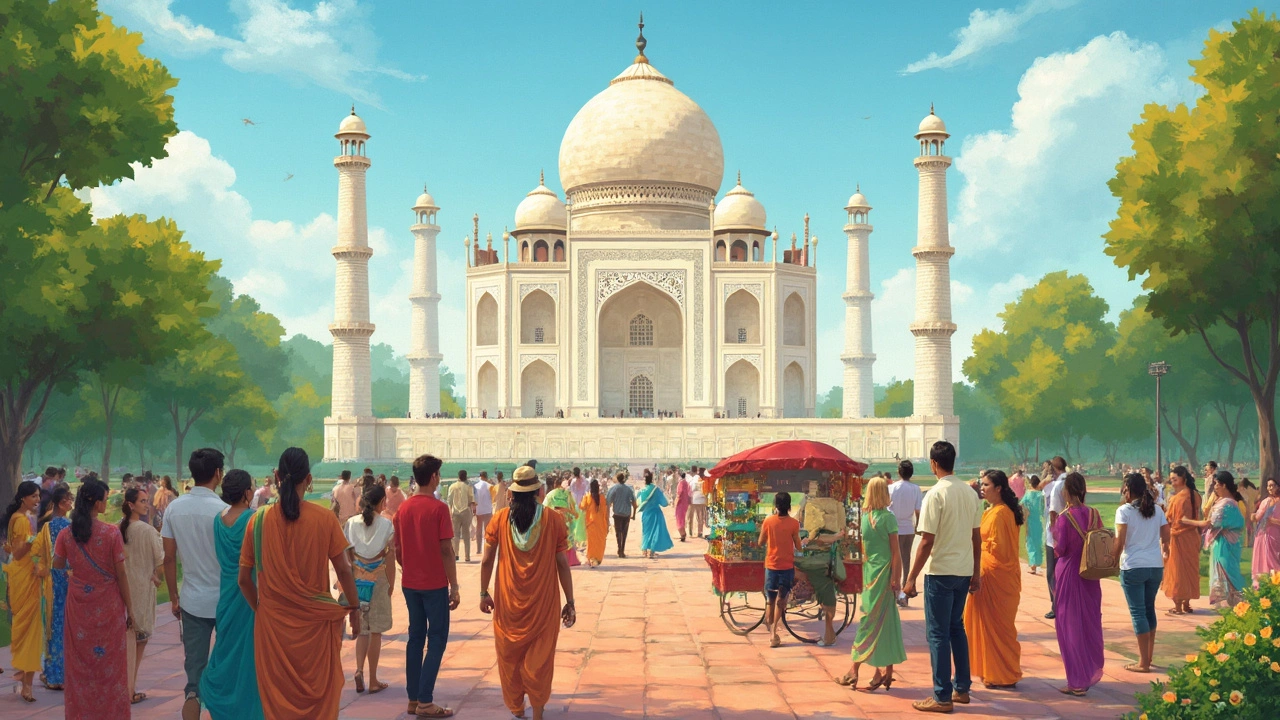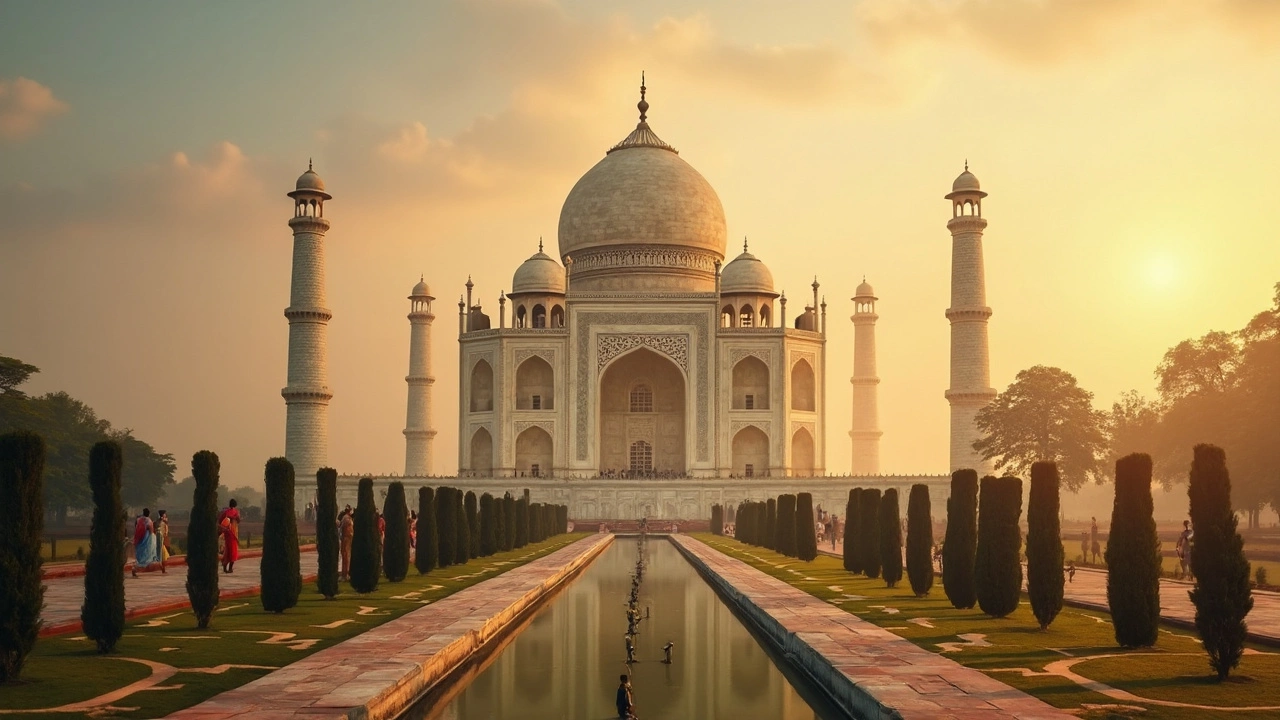India's got this amazing array of national monuments, and if there's one that steals the show, it's hands down the Taj Mahal. Chances are, you've already seen pictures of this beauty gracing everything from postcards to textbooks. It's sitting there in Agra like a gleaming pearl, drawing folks from every corner of the planet—not just because it's a stunner, but because of its incredible history and romantic aura.
Wanna know why this place is such a big deal? Let's dive into what's behind its legendary status and why it tops the bucket list for travelers around the globe. If you're planning a trip there, stick around for some insider tips that'll make your visit a breeze.
- Introduction to India's Monumental Heritage
- The Crown Jewel: Taj Mahal
- Unveiling the History
- Why It's So Popular
- Must-Know Tips for Visitors
- Conclusion and Reflections
Introduction to India's Monumental Heritage
India's monuments are more than just stone buildings; they're the storytelling pillars of a civilization that’s been evolving for thousands of years. It's like walking through a living museum that’s packed with everything from ancient forts, royal palaces, sacred temples, to vibrant memorials. Every monument is a chapter in history with tales of kings and queens, epic battles, and deep-rooted traditions.
Take the massive forts of Rajasthan, for example. They’re not just eye-catching; they're incredible feats of architecture. Or think about the intricate carvings and sculptures at Khajuraho, which aren’t just about art but also about showcasing life in its various forms.
The national monument vibe in India is really diverse—explore the bustling streets of Delhi with its Mughal-era wonders like the Red Fort and Humayun’s Tomb, or head to the southern stretches of Tamil Nadu to witness the majestic Brihadeeswarar Temple, a UNESCO World Heritage Site that stands as a testament to the Chola dynasty's grandeur.
Among these iconic structures, the most popular national monument has to be the Taj Mahal. Many travelers count it as a once-in-a-lifetime place to visit in India. It's been dubbed a masterpiece of architecture and it's not just a legend in India but all around the world. With its elegant white marble reflecting the changing hues of the sky, it's pure magic.
Here’s a little cheat sheet showing why these monuments are such a big deal:
- Cultural Significance: They tell stories about religious practices, lifestyles, and artistic expressions unique to different periods in Indian history.
- Architectural Wonders: Many were built with advanced engineering techniques that still baffle modern architects.
- Tourist Attractions: These sites are often at the top of the list for anyone exploring Indian culture or history.
So, when we talk about India's monumental heritage, it's not just about the buildings. It's about discovering the soul of a nation through its landmarks—each adding a piece to India's rich and diverse cultural mosaic.
The Crown Jewel: Taj Mahal
So, the Taj Mahal—this iconic masterpiece isn't just a monument; it's a love letter carved in stone. This jaw-dropping spectacle was built by Mughal Emperor Shah Jahan in memory of his favorite wife, Mumtaz Mahal. Yeah, that's right. It's the ultimate symbol of love, standing pretty since the 17th century.
Located on the banks of the Yamuna River in Agra, the Taj Mahal is considered one of the most beautiful buildings in the world. The story goes that Shah Jahan wanted to create something that would immortalize his wife's beauty forever, and boy, did he deliver! It took about 22 years and around 20,000 workers to bring this vision to life, using materials from all over India and Asia.
The architecture? Mind-blowing! It's a perfect blend of Indian, Persian, and Islamic styles, with white marble that changes color depending on the sunlight or moonlight. Fun fact: the Taj's minarets lean slightly outwards. Why? For safety, just in case of an earthquake. Now that's some next-level thinking from the 1600s!
If you're worried about the best time to visit, plan it around dawn or dusk. That's when it looks like magic. Oh, and here's a tip: skip Fridays if you're a tourist because the Taj Mahal is closed for prayers. You don't want to travel all the way to Agra only to find the gates shut.
Check out these quick stats:
| Construction Year | Architectural Style | Workers Involved |
|---|---|---|
| 1632-1653 | Indo-Islamic | 20,000+ |
Getting snaps of this place is on every traveler’s checklist, but try to actually spend a few moments just taking it all in. You'll see why this monument is not just a part of the Indian landscape; it's embedded in the nation’s heart and soul.
Unveiling the History
The Taj Mahal isn't just another pretty building; it’s packed with history, love, and maybe a dash of mystery. It’s the ultimate symbol of one man’s undying love for his wife. Picture this: the 17th century, and the Mughal Emperor Shah Jahan is head over heels for his wife, Mumtaz Mahal.
After she died in 1631, he decided to build something extraordinary in her memory. And thus, the Taj was born—well, started. It took a whopping 22 years and about 20,000 workers to bring his vision to life. Think of artisans from across India and even as far as Europe buzzing around with chisels and hammers, all working to carve out this masterpiece.
Adding a twist to its gorgeous white marbles are the precious stones from all over the world. There’s this crazy story that Shah Jahan wanted the Taj to have a twin made of black marble across the river. But guess what? His own kid, Aurangzeb, ended those plans by imprisoning him, keeping dad away from his architectural dreams. Isn't that some family drama?
Today, the Taj Mahal stands tall, not just as a UNESCO World Heritage site, but as an emblem of love history can never forget. When you walk around its gardens or gaze up at its majestic dome, you're not just seeing a building; you're stepping into a timeless story, one that's grasping onto its tales from centuries ago.

Why It's So Popular
The Taj Mahal isn't called the 'Crown Jewel' of India for nothing. This monument scores major points both for its jaw-dropping beauty and its loaded backstory. Built by Emperor Shah Jahan in memory of his wife Mumtaz Mahal, it's not just a building; it's a love letter carved in marble. And that whole love angle? Yeah, it's a big part of why folks are so drawn to it.
Visually, it's a stunner with the white marble dome set against the clear blue Agra sky. When the sun hits it just right, it's like the Taj Mahal changes color; from pinkish hues at dawn to golden shades by sunset. It's the kind of thing you'd totally save as a screen saver.
According to the Archeological Survey of India, about 7-8 million visitors check out the Taj Mahal every year. Those are some serious numbers, showing just how popular it is on a global scale. Plus, UNESCO listed it as a World Heritage Site back in 1983, cementing its status as a can't-miss destination.
- Unique architecture blending Persian, Islamic, and Indian styles.
- Craftsmanship that’s almost off the charts with intricate carvings and inlaid gemstones.
- The gardens—yep, they’re a perfect Instagram backdrop.
Local stories add to the mystique. For instance, some folks say Shah Jahan initially planned a 'Black Taj Mahal' across the river as his own tomb. While it probably doesn't exist, it sure fuels the imagination and fascination.
Must-Know Tips for Visitors
Planning to check out the Taj Mahal, the most popular national monument in India? Awesome choice! Here's the lowdown on making your visit smooth and unforgettable.
1. Best Time to Visit: While you can visit year-round, October to March is ideal because the weather's cooler. Avoid the heat and humidity of the summer months if you can.
2. Ticket Details: Tickets are available online and at the entrance. Prices differ for locals and foreigners, so ensure you pick the right one. Pro tip: book online to skip the regular queues.
3. Early Bird Catches the View: Arrive at dawn. Watching the sunrise over the Taj is pure magic, plus it's less crowded. You'll thank yourself later!
4. Dress Code & Gear: Dress respectfully—it's a cultural site after all. Comfy shoes are a must, and pack light. Backpack security checks can be a hassle.
- No Food Zone: You're not allowed to bring snacks inside. However, bottled water is cool. There's a cafeteria if you get hungry.
- Photography: Feel free to snap photos outside, but inside, it's a no-go for some areas. Keep an eye out for signs.
- Guide or No Guide: Going solo? Grab an audio guide for a narrated adventure at your pace. But if you love stories, hiring a local guide can be super enriching.
5. Nearby Attractions: Don't miss out on other jewels in Agra like the Agra Fort or Fatehpur Sikri, which are steeped in history and only a short ride away.
Enjoying the famous Indian monuments like the Taj Mahal is a treat. So lace up those walking shoes and get ready for a day full of awe. Have a blast!
Conclusion and Reflections
The Indian monuments collectively represent the diversity, history, and cultural richness of the country, but the Taj Mahal undeniably stands out as the crown jewel. It’s not just about the stunning architecture or the romantic tale; it’s about how a single structure can capture so much imagination and admiration. One minute you're standing before this massive marble masterpiece, and the next, you’re lost in thoughts of its incredible backstory.
Why does it rank the highest among India's national treasures? To start, it's a global symbol of love, thanks to Emperor Shah Jahan's tribute to his wife. Then there's its dazzling beauty—seriously, it looks like it’s been plucked from a dream when the sun hits just right. But beyond all that, the Taj Mahal is a living testament to artistry, history, and the enduring connections between cultures.
If you're thinking of paying it a visit, remember to plan around less crowded times or get your tickets in advance. Also, not many know about the early morning fog that adds a surreal touch to photos, and it’s worth getting up early for. With over 6 million visitors every year, allowances like these are what make the experience personal and memorable.
In the realm of national monuments, the Taj Mahal is a perfect blend of art and history that captivates everyone who sees it. And honestly? No amount of pictures can compare to standing there, witnessing its grandeur firsthand.
